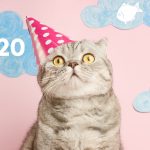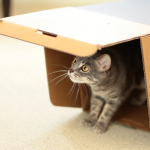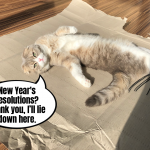Every cat sometimes pukes out a fur ball, has some light diarrhea, or gets the sniffles, but does every situation like this require an immediate vet visit? After all the barf could simply be caused by a hairball and the diarrhea be caused by a sudden change of food. That’s right – some of the typical cat ailments might seem so mundane a visit to the vet sounds like too much. But is it actually? In what situations are we actually able to help the cat at home and observe their symptoms and when we should really run to the closest vet asap? Let’s talk about it, fabCats!
A short tale about cats’ health
A cat’s health is not something we should experiment with. Compared to us, hoomans, a cat’s body is much more susceptible to changes and feeling poorly, and since cats are experts at hiding their symptoms, even the most experienced cat Carer might not realize something’s going on right away. Physical signs of an illness such as vomiting, diarrhea, weakness, lack of appetite, sneezing, panting, staggering, and high temperature are usually a stage where there’s no time to think – a vet should always be the first and best solution. And if you do react to all your cat’s strange symptoms by calling the vet, don’t worry – you’re not oversensitive, you simply want to make sure your cat lives their best life without pain or suffering.
Ok, but is every barf, a single oopsie in the litter box, or a temporary lack of appetite a sign to go to the emergency vet? Not necessarily. If we know our cats well, we can accurately assess the situation based on our previous experiences and we’re ready to go to the vet as soon as the situation gets worse, there are some cat ailments we may observe at home before taking action.
What to do when: a cat vomits
Vomiting is very tough on a cat’s body – not only does it empty out their entire stomach, making the cat weaker, but it also irritates their entire digestive system. We, hoomans, don’t like vomiting either but contrary to us, the cat won’t tell their Carer if they still feel bad or if that one puke made everything better.
If your cat vomits at home, try to assess what could be the cause of it. Was it a one-time event that doesn’t usually happen to your cat and the puke was mostly water and/or furballs and grass? Or maybe your cat vomited for the second or third time that day, throwing up food every time?
- if your cat is throwing up furballs once, it’s not a reason to worry just yet – it’s a natural reflex for cats who swallow some of their furs while grooming. At this stage, you can simply observe your cat – if they throw up the furball and besides that, they’re acting normal, have their appetite and energy, you don’t need to worry. Make sure your cat has access to fresh grass (available in most pet stores), an anti-fur ball paste, or supplements, and don’t forget to brush them regularly to make the grooming process easier and lower the risk of the cat swallowing their fur.
- if your cat is getting tired of vomiting, throws up for the second, or third time that day, if you know they’ve eaten something potentially harmful, or if you see that the vomiting comes with a lack of appetite, the cat being weak and not themselves, run to the vet. Vomiting might be a symptom of many difficult health issues, it causes dehydration, and it should never be ignored.
What to do when: the cat has diarrhea
Diarrhea, just like vomiting, can be a sign of serious health issues. But sometimes it’s only a case of changing food to a new one, the cat being stressed out, getting vaccinated, having worms, reacting to medicine, or eating food that wasn’t fresh. The contents of the litter box are one of the most important elements of health monitoring for cats, which is why:
- if the diarrhea happens once, e.g. after changing your cat’s food for a new one or while you’re transitioning to another type of food, it’s usually not a reason to be worried. Simply set aside the food that could’ve caused the issue, give your cat water and observe. If diarrhea doesn’t last for more than a day and your cat goes back to normal litter box routine after a few loose stools, it wasn’t that serious. What you need to do though is make sure your cat is properly hydrated, you can also give them some prebiotics to support their gut health and consult with the vet on your next visit. to make sure everything’s ok.
- if diarrhea happens alongside vomiting, lack of appetite, or other symptoms of health issues, or if you know the cat has eaten something they shouldn’t have, don’t wait up – it could be an infection, a strong allergic reaction to the food, or a first serious symptom of a more complex health issue. Book a vet appointment as soon as there’s one available because sometimes even a few hours can make a huge difference.
When it comes to diarrhea, you can help your cat with some white kaolin clay that you give them dissolved in water to stop diarrhea, calm down the gut, and replenish the nutrients diarrhea has taken away. However, if you don’t know what could have caused the cat to get sick, don’t give anything randomly – let the vet decide what course of action is the safest and best here.
What to do when: a cat limps
Cats are agile and nimble creatures but even a master of jumping on the walls can have an unfortunate landing and small injuries. The first rule of cat falls is: don’t panic – the cat is scared enough and doesn’t need your stress too. What can we do is inspect the paw (especially if we don’t know why the cat is limping) and look for wounds, bruises, and other surface injuries. It’s good to have bandages and disinfecting spray in your first aid kit to tend to a possible wound right away.
More on what to put inside your cat’s first aid kit on our blog:
The second step in case of an unexpected limping is observing the cat – how they move around, do they put any weight on the paw, are they mostly lying down and don’t move around much? Always look for signs of swelling too – if there’s been a sprain or a break, the paw will be painful, the cat won’t let you touch it, they might meow, pant, and lick the spot that hurts to ease the pain. If your cat behaves like this, a visit to the vet and immobilizing the paw might be necessary.
What to do when: the cat is panting
Panting isn’t a typical cat behavior – contrary to dogs who cool themselves down that way when they’re tired or hot, a cat panting means they are very tired, stressed, overheated, or have issues with their respiratory or blood circulation system. You should never ignore when your cat starts panting but:
- if it happens during an intensive playtime, simply stop the game and let the cat get some rest. If they go to drink some water and come back for more playtime in a moment, just make sure that it’s not as intense as before (we don’t want to cause the cat to pant anytime they finish playing).
- if it happens on a hot day, give your cat access to a cool, airy spot in the house, and to some water. You can open the door to your bathroom, put down a cooling mat, or even give them a wet towel if the cat wants to lay down on it. Don’t put a stream of air from a fan directly onto your cat as it may cause a cold.
- if it happens in a stressful situation, e.g. while traveling or having guests over, simply make sure to give your cat some space and a safe hiding spot. Let them use a room they can isolate themselves in, and cover the travel box with a blanket to muffle the noises. If your cat experiences stress regularly, it’s good to consult with a vet and when you expect a stressful situation to happen, give the cat something to calm them down as instructed by the vet.
Panting is a reason to worry and consult with the vet if it happens too often, without an apparent reason, or when it comes alongside other worrying symptoms we mentioned before.
What to do when: a cat lacks appetite
Cats can be easily divided into two groups: those who would eat anything, anywhere, anytime, and the fussy ones who treat even the slightest deviation from the usual as treason. Lack of appetite might happen to cats in both groups and every time we have the right to worry. What to do when a cat doesn’t want to eat?
- If your cat is usually fussy about their food and starts to reject their usual meal, start with making the food more appetizing, e.g. by sprinkling it with their favorite snack. Sometimes adding a tasty treat to the food is enough to make the cat see the contents of their bowl as worthy of their time.
- If your cat doesn’t usually have problems with food but has recently been eating less enthusiastically, monitor the amounts of food they consume each day. In the summer cats are less active because of the heat and less activity usually translates to lower appetite. If you give your cat some food for the night and everything is gone by the morning, the issue is probably not their appetite, but the heat outside.
- If your cat doesn’t want to eat, meows when they approach the bowl, eat small amounts, and doesn’t get the daily portion they should be getting with for their weight and activity levels, be careful. If the lack of appetite is paired with apathy, less activity, weight loss, diarrhea, vomiting, or other worrying symptoms, don’t ignore it and go to the vet quickly.
Remember: starving can be very dangerous to cats in a short period of time. Even 24 hours without food might lead to serious health problems so if your cat hasn’t eaten anything in a day, head straight to the vet’s office.
Being a cat Carer it’s always wise to follow the rule of “no case is too simple to see the vet about”. Even if we’ve learned to distinguish between a hairball and a serious puke, it’s never bad to be cautious. Being careful is always better than risking a cat’s health or life. Do you agree, fabCats? What symptoms do you usually consult with the vet?




